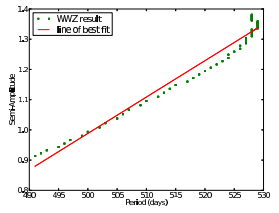 Several classes of pulsating stars are now known to undergo slow changes in amplitude; these include pulsating red giants and supergiants, and yellow supergiants. We have used visual observations from the AAVSO International Database, and wavelet analysis of 39 red giants, 7 red supergiants, and 3 yellow supergiants, to test the hypothesis that an increase in amplitude would result in an increase in period, because of non-linear effects in the pulsation. For most of the stars, the results are complex and/or indeterminate, due to the limitations of the data, the small amplitude or amplitude variation, or other processes such as random cycle-to-cycle period fluctuations. For the dozen stars which have substantial amplitude variation, and reasonably simple behavior, there is a 75-80% tendency to show a positive correlation between amplitude and period.
Several classes of pulsating stars are now known to undergo slow changes in amplitude; these include pulsating red giants and supergiants, and yellow supergiants. We have used visual observations from the AAVSO International Database, and wavelet analysis of 39 red giants, 7 red supergiants, and 3 yellow supergiants, to test the hypothesis that an increase in amplitude would result in an increase in period, because of non-linear effects in the pulsation. For most of the stars, the results are complex and/or indeterminate, due to the limitations of the data, the small amplitude or amplitude variation, or other processes such as random cycle-to-cycle period fluctuations. For the dozen stars which have substantial amplitude variation, and reasonably simple behavior, there is a 75-80% tendency to show a positive correlation between amplitude and period.
Authors: John R. Percy, Jeong Yeon (JY) Yook

